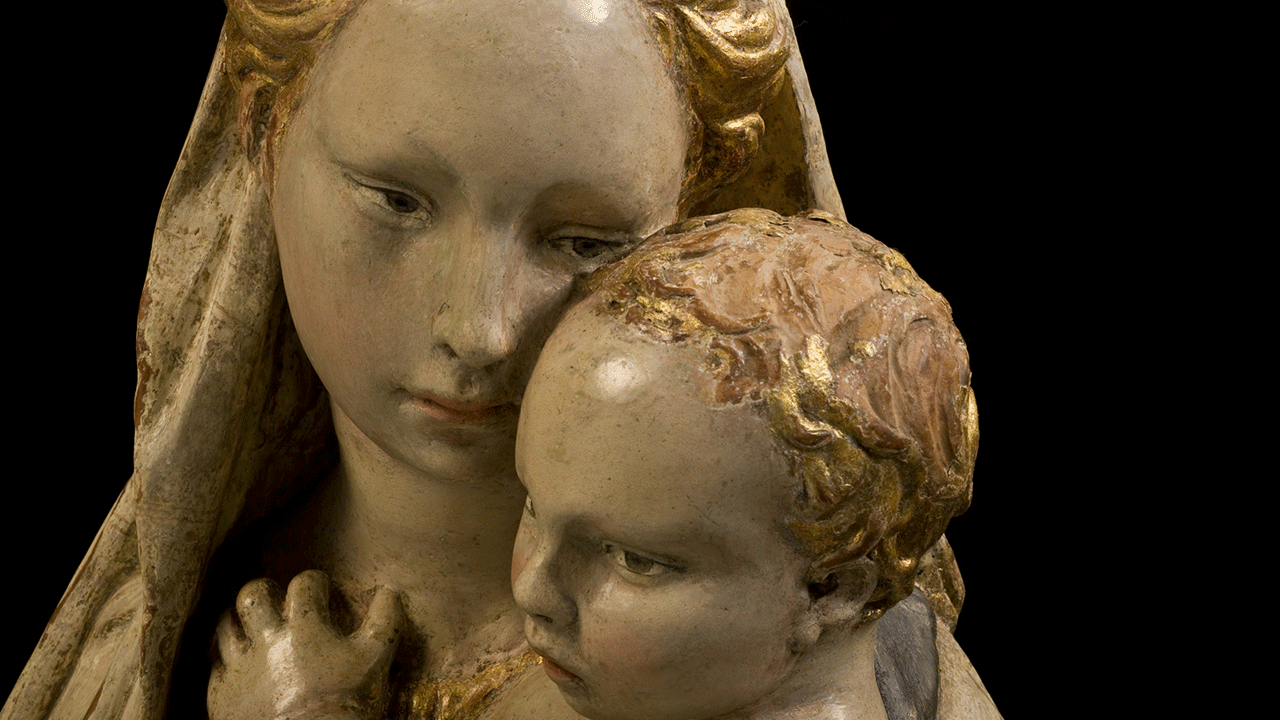
The Madonna and the Fortress of Citerna.
The “Madonna di Citerna” by Donatello, a cold-painted polychrome terracotta sculpture is a recent remarkable discovery. Present in the church of “San Francesco” from the mid-sixteenth century, the work has been subjected to heavy pictorial interventions that have hidden, preserving it, its extraordinary beauty.
Thanks to the intervention of the “Opificio delle Pietre Dure” in Florence, following the scientific analysis of the Art Historian Laura Ciferri, the sculpture was attributed to Donatello by the researchers Alfredo Bellanti, Corrado Fratini and Giancarlo Gentilini.
Today the sculptural group is visible in the original precious fifteenth century polychromy and the artwork is located in a dedicated environment, characterized by the correct microclimate which guarantees the appropriate state of preservation.
The “Madonna di Citerna” by Donatello, lies within this environment, located on the right side of the Choir of the Church of “San Francesco” of Citerna. It is the only work by Donatello in Umbria, and is an example of highest level of the skilful sculptural mastery of the artist, considered together with Brunelleschi and Masaccio, the father of the Italian Renaissance.
The oldest nucleus of Citerna is the “Cassero” or Fortress of Citerna, of langobardic origin (VIIth century), rebuilt in the fourteenth century, and ancient residence of the local lords.
The western bastion and the Round Tower, which has become the symbol of the town, complete the western side of the city wall.
Looking from the terrace which opens on the other side of the fortress, you can see the mountain of Verna, with its characteristic square shape and the mount Fumaiolo from which the Tiber river rises.
Up to its destruction, by the tremendous earthquake of 1917, near the fortress stood the “Pieve di San Michele Arcangelo” (XIIth century), the patron saint of the country that is celebrated every year on 8th May, perpetuating a worship introduced by the Langobards and bound to the sanctuary of “Sant’ Angelo al Gargano”.
Thanks to the intervention of the “Opificio delle Pietre Dure” in Florence, following the scientific analysis of the Art Historian Laura Ciferri, the sculpture was attributed to Donatello by the researchers Alfredo Bellanti, Corrado Fratini and Giancarlo Gentilini.
Today the sculptural group is visible in the original precious fifteenth century polychromy and the artwork is located in a dedicated environment, characterized by the correct microclimate which guarantees the appropriate state of preservation.
The “Madonna di Citerna” by Donatello, lies within this environment, located on the right side of the Choir of the Church of “San Francesco” of Citerna. It is the only work by Donatello in Umbria, and is an example of highest level of the skilful sculptural mastery of the artist, considered together with Brunelleschi and Masaccio, the father of the Italian Renaissance.
The oldest nucleus of Citerna is the “Cassero” or Fortress of Citerna, of langobardic origin (VIIth century), rebuilt in the fourteenth century, and ancient residence of the local lords.
The western bastion and the Round Tower, which has become the symbol of the town, complete the western side of the city wall.
Looking from the terrace which opens on the other side of the fortress, you can see the mountain of Verna, with its characteristic square shape and the mount Fumaiolo from which the Tiber river rises.
Up to its destruction, by the tremendous earthquake of 1917, near the fortress stood the “Pieve di San Michele Arcangelo” (XIIth century), the patron saint of the country that is celebrated every year on 8th May, perpetuating a worship introduced by the Langobards and bound to the sanctuary of “Sant’ Angelo al Gargano”.

 Italiano
Italiano Deutsch
Deutsch









